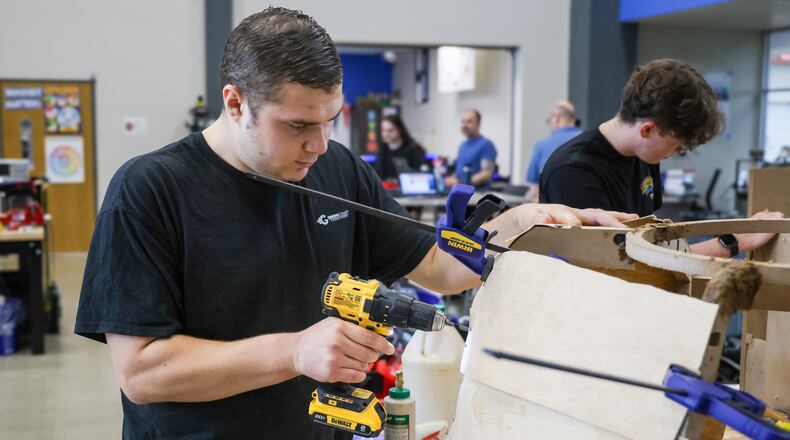Local career tech superintendents say that their waitlists persist, not because of inadequate investment in the present day, but rather because of a chronic failure to invest — both financially and culturally — in career tech students over the past 20 years.
“It was not hard to predict. Everybody knew there wasn’t that many people going into the trades ten years ago. You could plot it on a graph and see a problem was coming,” Miami Valley Career Tech Center Superintendent Nick Weldy said. “I started talking to different groups 10 years ago … I’d visit different businesses and I’d say ‘You‘ve got a hair problem ... Everyone in here has either gray hair or no hair.’”
Investments, waitlists growing
Miami Valley CTC opened their nearly 600,000-square-foot school building in Englewood last year, after almost five years of renovations. The $158 million renovation and expansion ($28 million of which was from the Ohio Facilities Construction Commission and millions from a 2017 bond issue approved by voters) expanded the school’s capacity from roughly 1,600 to 2,250 kids.
Simultaneously, MVCTC‘s waitlist has also grown from its historical average of 200-300 students.
“If we could have taken those extra, let’s say 300 kids (at the time), we would have been up to 1,900,” Weldy said. “Now we‘re up to 2,203, so not only did we take all those kids…we have gone above and beyond that, and we expect, actually, that the 2,203 number will reach 2,300. That’s probably going to be our absolute max.”
But MVCTC‘s waitlist has swelled to 534 students.
Many of those waitlisted are for specific programs. Health sciences, cosmetology, veterinary science, electrical, heavy equipment and welding are among the most highly requested programs in career tech schools across the Miami Valley.
Credit: Bryant Billing
Credit: Bryant Billing
MVCTC offers 43 career-technical programs, and nearly all are projected to be at full capacity for the 2025–2026 school year.
The Greene County Career Center opened their campus just off of U.S. 35 near U.S. 68 in 2020. The $70 million facility raised the career center’s capacity to 950 students, a number the career center exceeded two years ago.
Greene County’s waitlist has about 100 students.
“Next year, I think we‘re scheduled to have just under 1,100 students on campus,” Superintendent Dave Deskins said. “We are long at capacity already in our existing space.”
Butler Tech, Upper Valley
The much larger Butler Tech has several major expansions to its five campuses currently in the works: a $12.1 million expansion to its Bioscience Center, a $30 million Advanced Manufacturing Hub, developed with Miami University, and a $15 million Aviation Education Hangar at Middletown Regional Airport. All three of these are planned to open in January 2026.
“Rather than eliminate programs, Butler Tech’s strategy is to expand capacity and flexibility across multiple campuses and offer modular, short-term credentials to serve a broader student base,” said AJ Huff, public relations coordinator for Butler Tech.
Butler Tech serves 18,000 students across all five campuses, though that number encompasses adults and career tech high school programs, Huff said. Waiting lists for the schools vary by program.
Upper Valley Career Tech Center in Piqua is also in the middle of its own $18 million expansion, benefiting its Medical Careers Academy, First Responders Academy, sports medicine program, construction technologies, electrical trades, robotics, maintenance, and manufacturing and machining.
Upper Valley’s waiting list is 247 students.
Warren County
Last year, voters rejected a bond issue to fund a long-term plan to build a secondary campus for the Warren County Career Center. The entire project would have cost about $88.9 million, as the Ohio Facilities Construction Commission — which provides state dollars to build qualifying new government buildings — would have provided $21.7 million, or about 24%, if voters had approved the local share via the new tax.
Credit: Bryant Billing
Credit: Bryant Billing
Warren County CC also lost a $6 million career tech expansion grant for Fire, EMS, and Law Enforcement training because of the ballot measure, superintendent Joel King said. One of the conditions of the grant was that the school not try to pass a new money levy, which King said the school was unaware of when they voted to put the levy on the ballot.
Despite not having access to similar financial resources as other local schools, Warren County has undergone some major changes in the last five years. These include establishing their veterinary sciences program in 2020, and expanding its health science campus and welding programs around the same time, King said.
Warren County’s waitlist has grown from roughly 130 students last year, to around 200.
Warren County’s adult education enrollment is also surging, but the age group for those classes are trending younger, he added.
“We‘re starting to see that demographic of late teens to early and mid-twenties enroll in our adult education programs,” King said. “What we‘re seeing is many of them not having college degrees, but maybe they went for a semester and realized ‘college wasn’t for me, and there are job opportunities where I can make a lot of money.’”
Should we have built bigger?
When asked if he thought MVCTC should have built bigger, Weldy says they tried.
“The OFCC requires that you do an enrollment study and they use their vendor to do it,” he said. “We did not have a say. And we actually went back to them two or three times and said ‘This is not enough.’”
The Greene County Career Center school board has a few options to accommodate this growth, Deskins said, including expanding existing programs on campus, but also expanding “satellite” programs already in other Greene County schools.
These classes, led by career center teachers, but located at students’ home schools, give students access to career center opportunities, while staying in one place, a model mirrored in career tech schools across the Miami Valley in various forms.
The satellite model also gives students who are not enrolled in career tech programs a taste of what jobs are available, as oftentimes high schoolers don’t know what opportunities and careers are available to them.
Greene County even has age-appropriate career tech materials that are given out to first graders, including coloring and activity books, that aim to increase awareness among parents and students about possible career opportunities that are right for them.
“I believe that by us having a vision out, we‘re fixing this problem that we‘ve not done a good job on (fixing) so far, which is waiting until we‘re in crisis and trying to react,” Deskins said.
‘No longer either-or’
An additional reason for the surge in interest in career tech education, King said, is that stigmas around kids attending career tech schools are starting to shift.
Where career tech schools have historically carried the notion that their students don’t go on to further their education, data from the Warren County Career Center show that roughly 60% of them do go on to postsecondary education.
“We have so many students that are realizing this isn’t a either-or. It’s not ‘come here because I can’t go to college,’” he said. “These students have a very good understanding of what the possibilities are, and so I think that they (have) a better approach to their education.”
Not only does this address a workforce crisis, but it also addresses a crisis of purpose in students for whom college may not be the answer, a growing number of which are opting out of the workforce entirely.
“Last study that I saw, there were 90,000 kids who left high schools in Ohio that were not registered to go to college and had no credential, certification or training. That’s powerful in terms of a workforce,” Deskins said.
“We want those students to be looking for jobs that give them life sustaining wages. By providing the credentials, the certifications, the competencies that they need for those different positions, we‘re giving those students an advantage, whether they choose to go on to school, or whether they decide to look at different options.”
About the Author




